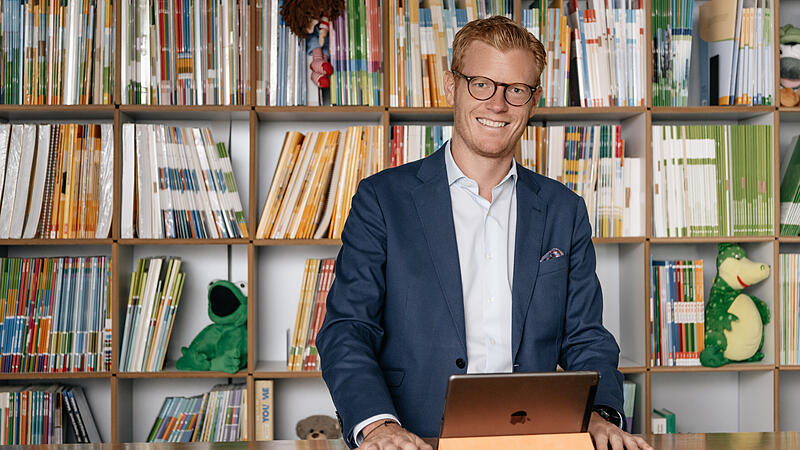Maximilian Schulyok said in an OÖN interview that one should not fall into blind digitization euphoria, even though the future of schools will be even more digital. But the book will also be important in the future.
The founding of the school book publishing house was a milestone.
Shulyok: Yes, and it’s a nice anniversary too. We’ve gained a lot of experience over the years, but we can’t buy any of it unless we’re there every year and look to the future.
Before we look to the future, let’s take a look at another anniversary: 50 years of textbook campaign. How important was the introduction?
The basic idea is extremely important, namely that the public purse pays for everything that the children need for their school education. That is still important today. But the question is how she will develop further, because the name says it all, she is extremely focused on the book.
How will she develop?
The book medium will continue to exist in the future, but it will play a different role. The school is becoming more digital, so the needs of the children can be addressed more individually, so they can better develop their potential. The “school book campaign” does not have to be reinvented, but it must cover the entire range of educational media – from books to a hybrid situation in which books and digital tools are used, to purely digital educational media.
Families were financially relieved by the textbook campaign at the time. The pandemic has given schools a massive boost in digitization…
… it has to be said that education in Austria is still passed on to a certain extent. In hardly any other European country is it so relevant what level of education and social status the parents have as it is here. This has intensified in the Corona period.
What are the advantages of analogue and digital media?
It varies from person to person – some need a book, others a digital platform. Some teaching functions, such as practice, can be better represented digitally. However, you have to be careful not to fall into a blind digitization euphoria, according to which everything that is digital is good and everything that is analog is outdated. Because that’s not true, when it comes to acquiring reading skills, we know from umpteen studies that it works much better with a book. You have to find the right medium for each individual and you can’t say across the board that we’re going to digitize the school.
School app developers advertise their learning apps with the fact that educators have more time for pedagogy again. Is that so?
Differentiation is difficult in an analogue world, a teacher would have to print out an individual worksheet for 25 children. In the digital world, this is much easier thanks to algorithms and artificial intelligence. That creates relief. On the other hand, we also have to enable teachers to deal with this digitization properly. Not only can we demand it, we also have to support them and train them. This is central if we want to increase the chance of digitization.
However, excessive digital consumption also harbors dangers: children can develop high blood pressure, short-sightedness, daytime tiredness…
Yes, because children also have their mobile phones in their hands at home, play games on the console, and when the laptop comes into play at school and homework has to be done online, then the screen time becomes excessive – that doesn’t make sense. Of course, there must also be analogous components in the lesson, so I’m not just talking about the book. Social learning is also important. There is no point in digitizing children’s entire lives. Professional life is also hybrid and not just digital. None of us can look at a screen twelve hours a day, so printed material is also needed.
The central medium in school is the book, digital media are the companion. Does that revolve?
Yes. We have the book as the main medium, and there are digital enrichments, interactive exercises. In the near future it will be possible to have the digital medium as the leading medium and reading supplements as well. But it’s not an either/or, it’s a togetherness. There are advantages in both worlds.
At the time, the textbook campaign was criticized for wasting resources…
Yes, but I can’t understand them. Sure, some books end up in the dustbin later, but look at Germany, that’s where the books are passed on. This means that the book is a bit slimmer, but much more complex to produce, with a hardcover, because it has to last five years. On the other hand, the parts of the work are much more extensive, because you are not allowed to write in the books. Both systems have advantages and disadvantages, but it’s not cheaper, and if I pass it on for five years, it’s going to be out of date. In the end, it’s about the education of young people, and that has a higher priority than the consumption of resources.
The market is big, in addition to the Austrian school book publisher there are many others like the Veritas publishing house. Does the competition revive?
There is a broad market – some are full-service providers, i.e. for all subjects, some have specialized. For geography alone, there are 20 different works in the textbook campaign for the upper grades, and every teacher can choose which product suits their teaching style better. Lots of supply means that every company has to work intensively on its product. This competition drives you to innovate. In some Swiss cantons there is a compulsory educational resource, for example in English every teacher must use the same book. And if you compare the quality with cantons where this obligation does not exist, then where there is competition, the product is better. A monopoly is never good.
Counting
The Austrian school book publisher has a portfolio of 2800 print products and 50,000 digital media
Source: Nachrichten




